I guess it’s natural for a photographer working in black and white to notice where things fall on the continuum between the two. Though all shades of gray are lovable, it’s more the extremes that seem to win my heart. It’s the attraction of pure yin and yang. It’s therefore a special delight when winter brings a reversal of this duality in one of my favorite subjects, namely streams and their ilk. Once there’s snow on the ground and ice forming on the bank, the water itself turns dark, just the opposite of the typical summer pattern of white water amid dark rocks or ground. Since a trip a couple months back along a local stream after the first big snowfall, I’ve been contemplating a series I tentatively called Black water. The early images didn’t seem especially promising, but I never found time to take a good crack at it.
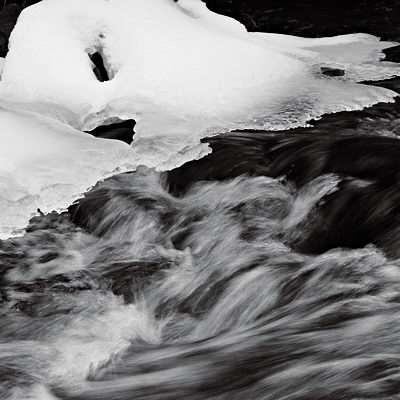 1
1
A week ago, late Sunday afternoon, I finally made it out to the semi-wilds, a place I’d never been, though not far from known territory. I was hoping to get to something interesting by snowshoe, which can actually be an easier way of traveling than by foot in summer. You don’t have to step or climb over all the obstacles, just walk above them on the nice, white carpet. The photograph above shows the main stream, Hyalite Creek, near where I started off. Admittedly, the water’s not entirely black, thanks to the foam and spray from turbulent spots. But where it runs smooth, it’s dark, dark, dark.
I soon left the stream at the first minor tributary, and ended up spending all my time along it, taking the series of photographs from which selections are presented below:
 2
2
 3
3
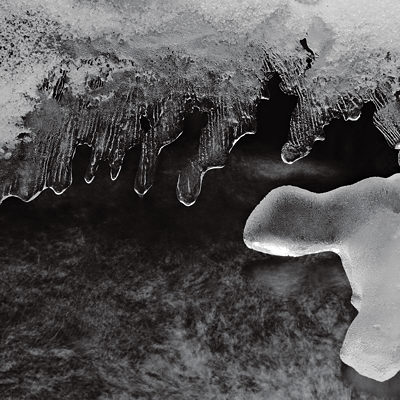 4
4
 5
5
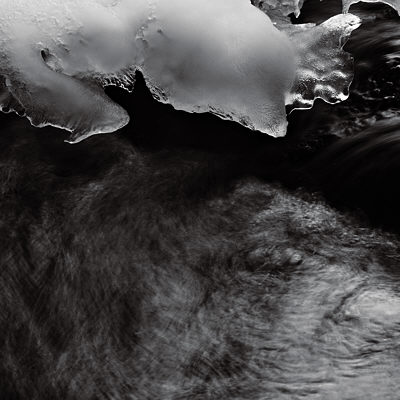 6
6
 7
7
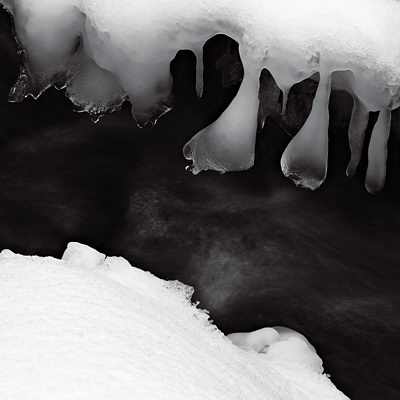 8
8
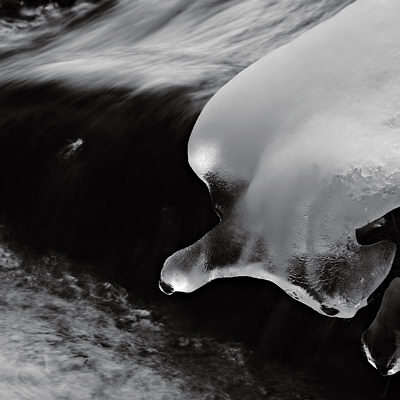 9
9
 10
10
The usual issue for me with such images is how far to abstract from the gray world—there’s very little color here, even before processing—toward a binary opposition, not unlike Jay’s white stake in a black heart. Because I liked the turbulent streamflow, I wanted to emphasize it more than in a “naturalistic” rendition, like the version below of #7 in the series:

On the other hand, I didn’t want to take the contrast all the way up to the fantastic or surreal, as in the version here:
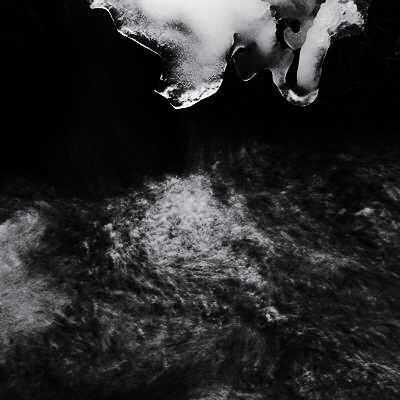
I do admit to liking, in the last one, the way the water is converted into astronomical imagery, not unlike the special case of the spray in Stardrops. But somehow, at the point where I am in this work (and all of it is still unsettled), it just feels overdone. I’ll go a certain distance from reality in my tendency toward abstraction, but I’m not ready to let it out of my sight.
How about you? How far do you go?
Update: I’ve renamed this series Dark Water and put it on my web site with a brief statement.

What excites me most are the different types of water flow – big brush strokes, swirling, gushing down in fine strands, boiling.
I like the second to last picture (version of picture 7) the best because it contrasts different types of flow.
The crystalline ice is darling. In pic 4, it looks lace.
Steve:
Reality? Sounds bad. I’d stay away.
That last image is my favorite as well. I’m constantly intrigued by all the ways that snow and Ice can be.
So my pie chart has been granted a glamorous name. Cool.
Hmmm, looks like you both disagree with my choice on #7 variants, in opposite directions. Just call me a wishy-washy compromiser.
No, you are right. Your version is the most subtle one.
No, you are right. Your version is the most subtle one with regard to both ice and water.
Steve,
I’m not going to choose among the images — only one cup of coffee yet, so I’m still foggy.
However, the odd thing that I see in the photos is that the white ice simply lays on top of the water, unattached as it were. It’s a strange effect, a bit like Birgit’s laying in the figure of the child with the shadows the opposite direction from the underlayer. It causes the viewer to have to see in and around and look again, rather than taking in the photo with a single glance.
Two things occur to me — one is that in some ways, the black and white is reminiscent of the woodblocks that I saw and helped print a couple of weekends ago. And the other is that you and Jay are working on shapes disentangled from reality, shapes that impede (in a good way) an immediate (and too often dismissive) vision of the subject matter. Part of your photos here are playing with rhythm and movement; the other part is very abstract expressionist. Combined they startle.
Birgit,
Ah, subtle is an epithet I can live with. The balance you point to between water and ice is the main trick, but I also thought about how much to emphasize or de-emphasize the structure within each.
June,
The snow and ice actually are above the water. They extend out from the sides of this small stream (roughly 1-3 feet wide), or are supported on rocks. You can indeed look under the ice, though of course it’s darker there.
Steve:
It’s always darker under the ice sounds like one of those truisms.
In January the Spaarne river Here in Haarlem froze over and everyone was skating. The ice was not VERY thick, however, and looking down into it, the impression of Black Water was strong, and eerie.